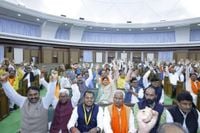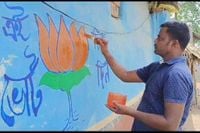After a stunning and decisive victory in the 2025 Bihar Assembly elections, the political landscape across India is reverberating with both celebration and soul-searching. The Bharatiya Janata Party (BJP)-led National Democratic Alliance (NDA) clinched a resounding win, securing 202 out of 243 seats, while the opposition Mahagathbandhan was left with a mere 35. Prime Minister Narendra Modi, buoyed by this triumph, addressed jubilant party workers at the BJP headquarters in New Delhi on November 14, declaring that the party would now aim to "uproot the jungle raj" in West Bengal, where elections are due in six months. This bold proclamation has already triggered sharp responses from regional parties, notably the Trinamool Congress (TMC), which insists that West Bengal will resist any BJP incursion.
But the Bihar verdict is not just a local story—it’s a political earthquake felt from the eastern heartland all the way to the deep South. In Tamil Nadu, where elections are due next year, the ruling Dravida Munnetra Kazhagam (DMK) subtly reminded its Congress ally that election victories are built on political clarity, coalition discipline, and welfare-driven credibility, not just catchy slogans crafted at the center. Meanwhile, the BJP’s local unit in Tamil Nadu sounded a note of optimism, though the party remains a marginal force in the state. The Bihar results have unmistakably forced parties across the spectrum to reconsider their strategies for the battles ahead.
So, what powered the NDA’s landslide in Bihar? According to Frontline, the alliance harnessed a potent mix of caste arithmetic, communal politics, and a massive direct benefit transfer: Rs 10,000 was credited to the accounts of 7.5 million women. This financial boost, delivered just before the polls, has drawn scrutiny, especially since it occurred while the Model Code of Conduct was in force. Still, it proved a political masterstroke. The NDA also benefited from a wide network of caste leaders and the deepening reach of subaltern Hindutva, as well as strong partnerships with caste-based parties led by Nitish Kumar, Chirag Paswan, and Jitan Ram Manjhi.
Meanwhile, the Mahagathbandhan, anchored by the Rashtriya Janata Dal (RJD), found itself unable to expand beyond its traditional Muslim-Yadav (MY) support base. RJD leader Tejashwi Yadav managed to retain his family’s stronghold in Raghopur, but his victory margin shrank dramatically—from 38,000 votes in 2020 to just 11,000 this year. The Congress, for its part, won only six of the 61 seats it contested, translating to a strike rate of less than 10 percent. As for the Communist Party of India (Marxist–Leninist) Liberation, its performance also plummeted, securing just two of the 20 seats it fought for.
But the election’s aftermath has been just as turbulent as the campaign itself. On November 15, Tejashwi Yadav’s sister, Rohini Acharya, publicly criticized him and his team, exposing family fissures that have since dominated headlines. According to Frontline, such internal squabbles have compounded the RJD’s woes, with trust eroding not only among non-Yadav groups but also within its core base. Mohammad Sajjad, professor at Aligarh Muslim University, observed that even in the Seemanchal region, the Mahagathbandhan’s campaign failed to resonate beyond its traditional supporters. He noted, "Extremely Backward Caste (EBC) voters were not keen on supporting it. The reasons varied from their fear of domination of Yadavs to lower representation in ticket allocation."
The Congress party, meanwhile, is facing its own moment of reckoning. Senior leader Shakeel Ahmad resigned just days before the results, citing his exclusion from decision-making. Another Congress figure, Kishore Kumar Jha, argued that the party should reconsider alliances with regional outfits, stating, "Tejashwi Yadav mainly campaigned with [VIP leader] Mukesh Sahani and I.P. Gupta [head of Indian Inclusive Party] and tried to push the backward versus upper caste narrative, which does not gel with a centrist party like the Congress. People rejected this caste-centric politics."
Yet, amid all the talk of coalition math and campaign strategies, one story stands out: the extraordinary turnout of women voters. Over 71 percent of women cast their ballots, outpacing the male turnout of 62.8 percent. Analysts, as reported by The Hindu, have debated whether this marks the "feminization of democracy" in Bihar. The mass migration of men from the state for economic reasons is believed to have unintentionally spurred a political awakening among women left behind.
However, this surge in participation belies a stubborn reality: women remain drastically underrepresented as candidates and legislators. The 2025 elections saw only 258 women contesting against 2,357 men—the lowest number of female candidates in 15 years. The NDA fielded 35 women (14.40 percent of its total), the INDIA bloc just 32 (13.16 percent), and Jan Swaraj 25. Only 28 women were elected, making up just 11.5 percent of the assembly. This is hardly a revolution in representation. As The Hindu points out, "these transactional offerings treat women as recipients of policies, rather than their authors."
The contrast is stark. While women voters are courted with welfare schemes and pre-poll cash transfers, their presence in the corridors of power remains marginal. In 2020, only 26 women were elected to the 243-member assembly; in 2015, it was 28. The high-water mark was 34 in 2010. This pattern is not unique to Bihar but reflects a broader national trend of gender exclusion in Indian politics. Parties continue to cite "winnability" as a reason to sideline women from ticket allotment, perpetuating a male-dominated political culture.
Some victories do stand out, such as Baby Kumari winning in Bochahan, Kavita Devi retaining Korha, and Sonam Rani triumphing in Triveniganj. But these are exceptions that prove the rule. As the election dust settles, it’s clear that while women’s participation as voters is on the rise, their representation as leaders is still woefully inadequate. The cash transfers, while politically effective, have not translated into structural change or genuine empowerment.
Looking ahead, the Bihar results are forcing parties to recalibrate not only in West Bengal and Tamil Nadu but also in states like Gujarat, Haryana, Maharashtra, and Delhi. The BJP’s 2025 landslide in Bihar echoes its 2022 sweep in Gujarat, where it won 156 seats after a period of internal consolidation. For the Congress, which has struggled in state after state, the Bihar debacle raises uncomfortable questions about leadership and strategy. The party’s "vote chori" campaign and push for a caste census have failed to halt its decline in the Hindi heartland and beyond.
Meanwhile, the opposition INDIA bloc faces its own leadership tussles. Calls have grown for West Bengal Chief Minister Mamata Banerjee to take the national helm, especially after Congress’s poor showing. Even within the Samajwadi Party (SP) and Jharkhand Mukti Morcha (JMM), leaders are asserting their claims to greater influence, further complicating alliance dynamics.
As Manindra Thakur of Jawaharlal Nehru University told Frontline, "The Bihar Assembly election results mark a predictable yet consequential realignment of caste and social coalitions that shaped the electoral outcome. All NDA partners delivered significant voter segments, and despite occasional internal frictions, their collective arithmetic held firm." Yet, he cautioned, the road ahead is fraught with challenges—especially for Nitish Kumar, who must now deliver on promises of development and economic revival, even as direct fund transfers strain the state’s finances.
In the end, the 2025 Bihar elections have served as a mirror for Indian democracy: reflecting both its evolving strengths and its persistent weaknesses. The surge in women’s participation is a hopeful sign, but true progress will only come when the politics of presence finally breaches the state’s political chambers, transforming women from the objects of policy into its authors.






